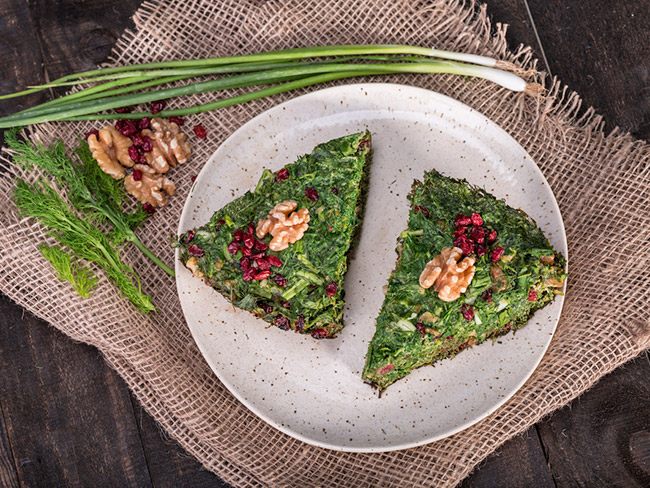Persian herb frittata
Fresh herbs are the star in this egg dish.
The first time I had kuku sabzi, or Persian herb frittata, I was still in the early days (and daze) of motherhood with my first baby. A dozen people could have shared this lunch, even though there were only two couples and two nonsolid-eating babies.
The Persian herb frittata stood out to me because it was new — elegant squares of frittata, dense with bright green herbs, served alongside fresh radishes and the most delicate almonds and walnuts I had tasted.
No detail was left behind; the nuts had been soaked the night before and then peeled, one by one. Persian cuisine uses herbs generously, both raw and cooked. Sabzi khordan, served as a starter and accompaniment to every meal, is a plate of fresh herbs, lavash, walnuts, radishes, and feta.
I was a bit bewildered when presented with this for the first time, but I soon loved the idea of grabbing bunches of herbs (especially piquant tarragon), stuffing them into a piece of lavash and devouring.
This recipe is based upon a handful of recipes that I’ve read, researched, tested, and adjusted. This version is cooked on the stovetop, but alternatively, you can cook one side on the stove, then finish it under a broiler, which will leave the top an even more vibrant green. I also added turmeric for color and a "hmm, what’s in this?" subtle undertone.
Enjoy your frittata!
Servings: 8
Prep time: 10 minutes
Ingredients
- 5 eggs
- 1 tablespoon dried fenugreek leaves, crushed
- 1 teaspoon baking powder
- 1/2 teaspoon fine Kosher salt
- 1 teaspoon freshly ground black pepper
- 1/2 teaspoon ground turmeric
- 1 bunch scallions, sliced thinly
- 1 1/2 cups fresh parsley, leaves and small stems, finely chopped
- 1 1/2 cups fresh cilantro, leaves and small stems, finely chopped
- 1 1/2 cups fresh dill or mint leaves, finely chopped
- 1/3 cup walnuts, toasted and chopped finely
- 1 or 2 tablespoons dried barberries, cranberries, currants, or chopped dried sour cherries, soaked in water until soft, then drained
- Canola or other vegetable oil, for frying
- Optional garnishes: fresh herbs, sliced radishes, walnuts
Directions
- Whisk together eggs, fenugreek, baking powder, salt, pepper, and turmeric in a large bowl. Fold in chopped herbs (scallions, parsley, cilantro, dill, or mint leaves), walnuts and barberries, cranberries, currants or chopped dried sour cherries, if using.
- Warm a nonstick pan with 2 to 4 tablespoons of oil (enough to cover bottom of pan) over low heat. Pour in the egg mixture, then flatten the top with a spatula to distribute the herbs evenly. Cook covered for 5 to 10 minutes, until the bottom is set (check by lifting the edge with a spatula).
- Use the edge of a spatula to cut into four pieces* and carefully flip each piece using two spatulas. Cook for another 5 to 10 minutes, uncovered, until cooked through.
- Cut into 8 wedges and place on a serving platter. Garnish with fresh herbs, radishes, barberries.
*Ideally, you can invert the frittata without cutting if you have a plate slightly larger than the diameter of your pan. Place the plate over the top of the pan, invert it (so that the cooked bottom is now on top), then slide the inverted frittata back into the pan to cook the other side.
Nutrition Information (per serving)
- Calories: 89
- Total fat: 6 g
- Protein: 6 g
- Sodium: 105 mg
- Total sugars: 1 g
Recipe contributed by Linda Shiue, MD.
